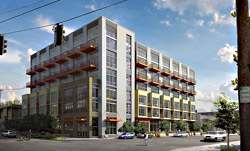Heading down East Pine recently to see Theater Schmeater’s production of tempOdyssey, Dan Diemeck’s enjoyably surreal satire on office life, I passed through what I call the Gloom Zone. It’s a stretch of bars and restaurants between Summit and Belmont that are living under a death sentence, their varied nightlife soon to be replaced with yet another yummy ginormous condominium. It’s depressing enough to be losing a half-dozen good bars, but seeing as this fated block is only a short distance away from Schmeater, I’m nervous that the unstoppable Condo Congo will soon bury every smaller theater venue in town. (For the record, the Schmee’s managing director has said that relations with their current landlords are good, and that they have no immediate plans to find a new space.)
But lo and behold, some good news arrived in my inbox just two days later: a copy of “Arts Space Incentives,” a study prepared for Seattle’s Office of Arts and Cultural Affairs by the real estate firm GVA Kidder Mathews. Using the South Lake Union neighborhood as a test case, the report discusses some potential incentives for property owners willing to incorporate art spaces in their development.
The idea has been kicking around for a long time. I first heard about it 10 years ago from Jim Kelly at the King County Arts Commission, who pointed me toward similar successful programs in New York and Chicago. Essentially, a developer takes underutilized space in his building, space with limited commercial appeal, and either donates it to an arts group or offers it for greatly reduced rent. Thus, a windowless storage room becomes a black-box theater, or a small office becomes a gallery, or a parking area becomes a multiuse performance space.
The new study identifies buildings in the South Lake Union area that are likely to be developed in the next 20 years, and notes which ones would be suitable for this kind of use. Then it goes on to suggest some incentives that could be offered to property owners to encourage them to donate the space.
South Lake Union “seemed like a natural place to start,” says Arts and Cultural Affairs executive Michael Killoren. “This gives us a template that we can use in looking at other neighborhoods as well.”
The incentives would allow developers to work around various regulations: Add a theater in your basement, get some additional floors added to the height of your building. It also puts forward the idea of property owners getting credit in a development-rights “bank,” so that space donated in one building could result in an easement for another building owned by the same developer.
The incentives are smart and seem workable, based not only on efforts in other cities but on the success of Seattle’s efforts to do the same thing with developers compensating for displaced lower-income housing. But one of the things it doesn’t address is the benefits to a developer that an arts space can bring, and I’m not just talking about the often-reported statistics about how art spaces bring up neighboring property values and bring down crime rates.
As condos shoot up around Seattle like architectural kudzu, one of the problems they face in attracting new tenants is in somehow distinguishing themselves from what every other condo in the city can offer. Seeing as on-site amenities like a gym, meeting rooms, and Wi-Fi are old hat, an on-site theater or arts gallery might be just the thing to set your collection of balconied urban boxes apart from the crowd. You don’t get much more immediate access to the arts than taking an elevator down a couple floors to buy your ticket. What’s more, a theater company in the building might actually accomplish the goal that monthly meetings of the condo association never seem to accomplish: turning a condo into a full-fledged community, with its own identity, cohesiveness, and pride.
John Longenbaugh




